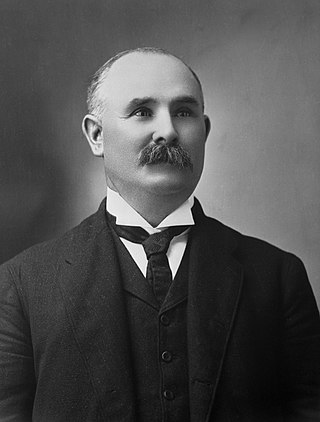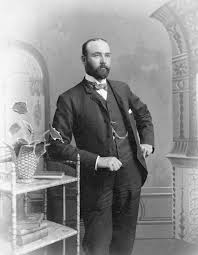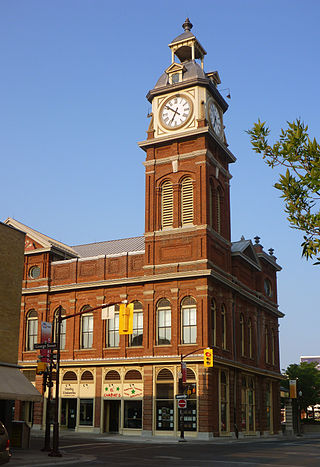
The Bank of America Corporate Center is an 871 ft (265 m) skyscraper in Uptown Charlotte, North Carolina. Designed by Argentine architect César Pelli and HKS Architects, and best known as the headquarters of the namesake Bank of America, it has been the tallest building in North Carolina since its 1992 construction, and is the 56th tallest building in the United States as well as the 174th-tallest building in the world.
The Southern Alberta Institute of Technology (SAIT) is a polytechnic institute in Calgary, Alberta, Canada. SAIT offers more than 110 career programs in technology, trades and business. Established in 1916, it is Calgary's second oldest post-secondary institution and Canada's first publicly funded technical institute.

Arts Commons is a multi-venue arts centre in downtown Calgary, Alberta, Canada, located in the Olympic Plaza Cultural District.

The Metropolitan Life Insurance Company Tower is a skyscraper occupying a full block in the Flatiron District of Manhattan in New York City. The building is composed of two sections: a 700-foot-tall (210 m) tower at the northwest corner of the block, at Madison Avenue and 24th Street, and a shorter east wing occupying the remainder of the block bounded by Madison Avenue, Park Avenue South, 23rd Street, and 24th Street. The South Building, along with the North Building directly across 24th Street, comprises the Metropolitan Home Office Complex, which originally served as the headquarters of the Metropolitan Life Insurance Company.

Downtown Calgary is a dense urban district in central Calgary, Alberta. It contains the second largest concentration of head offices in Canada, despite only being the country's fourth largest city in terms of population. The downtown is divided into several residential, commercial, corporate, and mixed-use neighbourhoods, including the Financial District (CBD), Eau Claire, Chinatown, East Village, Beltline, and the West End.

Chelsea Market is a food hall, shopping mall, office building and television production facility located in the Chelsea neighborhood of the borough of Manhattan, in New York City. The Chelsea Market complex occupies an entire city block with a connecting bridge over Tenth Avenue to the adjacent 85 Tenth Avenue building. The High Line passes through the 10th Avenue side of the building.
The Cultural District is a fourteen-square-block area in Downtown Pittsburgh bordered by the Allegheny River on the north, Tenth Street on the east, Stanwix Street on the west, and Liberty Avenue on the south.

Patrick Burns was a Canadian rancher, meat packer, businessperson, senator, and philanthropist. A self-made man of wealth, he built one of the world's largest integrated meat-packing empires, P. Burns & Co., becoming one of the wealthiest Canadians of his time. He is honoured as one of the Big Four western cattle kings who started the Calgary Stampede in Alberta in 1912.
The Shops at North Bridge, once known as Westfield North Bridge, is an upscale, urban retail-entertainment district in Chicago, Illinois, located at 520 N. Michigan Avenue. Its anchor store is Nordstrom. Its name alludes first to its location within the nine-block North Bridge complex and to the literal distinction of the shopping center incorporating four-level enclosed bridges over both east Grand Ave, and north Rush Street.

The Hammond Building was a high-rise building completed in 1889 at the southeast corner of Griswold Street and West Fort Street in the financial district of downtown Detroit, Michigan directly across Fort Street from the Detroit City Hall. The 46 m (151 ft) building was designed by George H. Edbrooke, and is considered the first skyscraper in the city, and was the tallest in the state when built. Russell Wheel & Foundry supplied and erected the iron and structural steel for the building. The Hammond Building was demolished in 1956 to make way for the National Bank of Detroit Building, which has since been renamed The Qube. At 12 stories, the steel-framed United Way Community Services Building (1895), originally the Chamber of Commerce Building, qualifies as Detroit's oldest existing skyscraper.

The Bow is a 158,000-square-metre (1,700,000 sq ft) skyscraper in downtown Calgary, Alberta, Canada. The 236 metre (774 ft) building was the tallest in Calgary between July 8, 2010, when it surpassed the Suncor Energy Centre, and May 11, 2016, when it was exceeded by Brookfield Place. The Bow is currently the second tallest office tower in Calgary and the third tallest in Canada outside Toronto. The Bow is also considered the start of redevelopment in Calgary's Downtown East Village. It was completed in 2012 and was ranked among the top 10 architectural projects in the world of that year according to Azure magazine. It was built for oil and gas company Encana, and was the headquarters of its successors Ovintiv and Cenovus.

The Grand, stylized as The GRAND, is the oldest theatre in the downtown core of Calgary, Alberta, Canada. In its current incarnation, it houses and operates the 436-seat Flanagan Theatre and a rehearsal space, the Studio.

Burns Manor was the Calgary residence of Senator Pat Burns, a successful businessman who founded Burns Meat. It was located at 510 13th Avenue S.W. in the Beltline District of Calgary, Alberta. Construction started in July 1900 and was completed in January 1903. The property was torn down in May 1956 to make room for an expansion of the Colonel Belcher Hospital..

The Bellingham National Bank Building is an historic commercial/office building located in downtown Bellingham, Washington. It was originally built from 1912 to 1913 in a restrained Beaux Arts commercial style with reinforced concrete. Even though this particular style was common for cities in the midwest and east coast, the building style was a stark contrast for Bellingham's sandstone and rounded arch buildings. The Bellingham National Bank occupied the building starting on December 1, 1913.

The Strathcona Public Building, Old Strathcona Post Office, South Side Post Office or South Edmonton Post Office is restored heritage building in Strathcona Square in the Old Strathcona heritage district of Edmonton. The restored building along with a Festival Market was opened to the public on the first weekend of September 1988 and the place came to be known as Strathcona Square.

Downtown East Village more commonly known as simply East Village, is a mixed-use neighbourhood within the eastern portions of downtown Calgary, Alberta, Canada. It is contained within the city's Rivers District. Containing the earliest-settled land in the Calgary area - Fort Calgary - East Village was for years a mixture of high-rise residential, commercial, and industrial development. Much of the parkland currently surrounding Fort Calgary was industrial as recently as the 1960s. Construction of the city's light rail transit Blue Line, coupled with the closure of 8th Avenue at Macleod Trail in the early 1980s by construction of the massive Calgary Municipal Building, resulted in East Village being "cut off," from the rest of downtown. It became home to many rundown properties and vacant lots over the years, and a severe crime problem.
The Barron Building is an eleven-storey office tower located at 610 8th Avenue Southwest in Calgary, Alberta, Canada. Designed by architect Jack Cawston and built between 1949 and 1951, it is one of Canada's foremost examples of Art Moderne-style architecture. In 2003 it was named by the Alberta Association of Architects as Significant Alberta Architecture.

William Charles James Roper Hull was a Canadian rancher, meat packer, businessman, and philanthropist. He played a prominent role in western Canada's early economic development by integrating a systematic approach to cattle raising, meat processing, and retailing on a large scale in Alberta.

Market Hall is a commercial building and performing arts centre in the downtown core of Peterborough, Ontario, Canada. Originally built as the city's market hall, it has housed a variety of tenants since and has been home to the Market Hall Performing Arts Centre since 1998.

The Paramount Theatre is a historic movie theatre in Edmonton, Alberta, Canada.

















